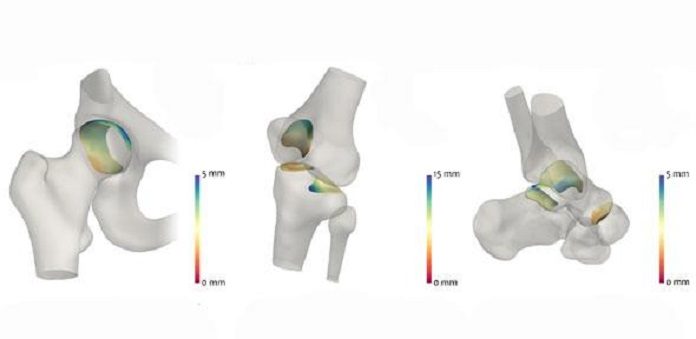Scientists at the University of Cambridge have developed a new algorithm to monitor the joints of patients with arthritis. It detects tiny changes in arthritic joints, could enable greater understanding of how osteoarthritis develops and allow the effectiveness of new treatments to be assessed more accurately, without the need for invasive tissue sampling.
Normally, x-rays are used to identify Osteoarthritis by a narrowing of the space between the bones of the joint due to a loss of cartilage. However, x-rays do not have enough sensitivity to detect subtle changes in the joint over time.
The novel technique uses images from a standard computerized tomography (CT) scan and produces detailed images in three dimensions.
The algorithm originally uses a semi-automated technique, called joint space mapping (JSM) to identify changes in the space between the bones of the joint in question, a recognized surrogate marker for osteoarthritis.
When testing the algorithm on human hip joints from bodies, scientists found that it exceeded the current ‘gold standard’ of joint imaging with x-rays in terms of sensitivity, showing that it was at least twice as good at detecting small structural changes. Color-coded images produced using the JSM algorithm illustrate the parts of the joint where the space between bones is wider or narrower.
Dr Tom Turmezei from Cambridge’s Department of Engineering said, “Using this technique, we’ll hopefully be able to identify osteoarthritis earlier and look at potential treatments before it becomes debilitating. It could be used to screen at-risk populations, such as those with known arthritis, previous joint injury, or elite athletes who are at risk of developing arthritis due to the continued strain placed on their joints.”
“We’ve shown that this technique could be a valuable tool for the analysis of arthritis, in both clinical and research settings. When combined with 3D statistical analysis, it could be also be used to speed up the development of new treatments.”
According to the researchers, the success of the JSM algorithm demonstrates that 3D imaging techniques have the potential to be more effective than 2D imaging. In addition, CT can now be used with very low doses of radiation, meaning that it can be safely used more frequently for the purposes of ongoing monitoring.
The study is published online in the journal Scientific Reports.
